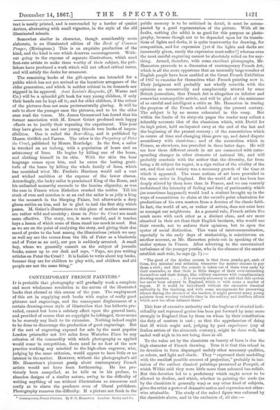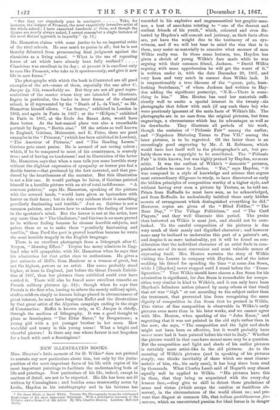CONTEMPORARY FRENCH PALNTERS..
IT is probable that photography-will gradually work a complete and most wholesome revolution in the nature of the illustrated books that abound at this season of the year. The employment of this art in supplying such books with copies of really good pictures and engravings, and the consequent displacement of a certain drawing-room style of illustration that has hitherto pre- vailed, cannot but have a salutary effect upon the general taste, and provided of course that no copyright be infringed, there seems to be scarcely any limit to its extension. Nothing indeed ought to be done to discourage the production of good engravings. But if the sort of engraving exposed for sale by the most popular London printseller not 100 miles from Waterloo Place be any criterion of the commodity with which photography so applied would come in competition, there need be no fear of the new practice working any mischief to the high-class engraver, who, judging by the same criterion, would appear to have little or no interest in the matter. However, without the photographer's aid Mr. Hamerton's pleasant gossip about contemporary French artists would not have been forthcoming. He has pre- viously been compelled, as he tells us in his preface, to abandon designs of a similar nature, owing to the difficulty of writing anything of use without illustrations so numerous and costly as to alarm the prudence even of liberal publishers. Photography removes the difficulty. If a picture not fresh in the Contemporary French PainterL By P. G.,Hamerton. London: Seeley and Co. public memory is to be criticized in detail, it must be accom- panied by a good representation of the picture. With all its
faults, nothing (he adds) is so good for this purpose as photo- graphy, because though not to be depended upon for its transla- tions of lights and darks, it is quite trustworthy for drawing, for composition, and for expression [yet if the lights and darks are incorrectly given, surely the expression must suffer?] whereas even the most careful engraving cannot be absolutely relied on for any- thing. Armed, therefore, with some excellent photographs, Mr.
Hamerton proceeds to a discussion of contemporary French Art, which is all the more opportune that an unusually large number of English people have been enabled at the Great French Exhibition of 1867 to examine for themselves what French painting now is.
Their judgment will probably not wholly coincide with the opinions so unreservedly and complacently uttered by some British journalists, that French Art is altogether an inferior and somewhat contemptible article, and will be glad of the assistance of so careful and intelligent a critic as Mr. Hamerton in tracing the progress of the French school during the present century. The subject is by no means exhausted in this essay. But within the limits of its sixty-six pages the reader may collect a tolerably accurate ideii of the classicism which, with David for its high priest, held undisputed sway at the end of the last and the beginning of the present century ; of the romanticism which in course of time and changing ideas grew up, and dared dispute ascendancy with classicism ; and of the naturalism which in France, as elsewhere, has prevailed in these latter days. He will see how these different creeds in art are connected with corre- sponding changes in other elements of national life, and will probably conclude with the author that the diversity, far from being a fit subject for regret, is a sign rather of the vitality of the art, and that each variety was a necessary growth of the time at which it appeared. The same notions of art have prevailed in the same order in England. But the world of art has been less deeply stirred by them here than in France, and we can scarcely understand the intensity of feeling and fury of partizanship which (as sometimes happened) would lead a student brought up in the ways of romanticism to claim at the sword's point admiration for productions of his own masters from a devotee of the classic faith.
In fact, the world of art, or rather of artists, does not exist here as amongst our neighbours. As a general rule, French artists live much more with each other as a distinct class, and are more absorbed in their art than their English brethren, who would use their swords, not to enforce their opinions, but to open the oyster of social distinction. This want of intercommunication, especially in the early days of studentship, is mischievous on another account, as Mr. Hamerton points out in speaking of the atelier system in France. After adverting to the unrestrained turbulence of the younger youths, who in the absence of the master establish mob rule, he says (p. 7) :—
" The good of the Atelier system is that these youths get, each of them, five minutes' real criticism whenever the master chooses to pay- them a visit ; and that the conceit is taken out of them very early by- their comrades, so that their is little danger of their over-estimating themselves and their doings, like solitary amateurs with complimentary drawing-masters. . . . . It is scarcely necessary to add that this system has never been adopted in England, which is with some a matter of regret. If it could be introduced without the excessive classical authority in the teaching, and with some arrangement for preserving silence during the absence of the teacher, it might prevent many young painters from wasting valuable time in the solitary and fruitless efforts which now too often exhaust them."
This fear of excessive authority and the bugbear of stunted indi- viduality and repressed genius has been put forward by none more strongly in England than by those on whom by their constitution the duty of masters is cast ; so that the apprehension of doing that ill which ought and, judging by past experience (say of Italian artists of the sixteenth century), might be done well, has ended well nigh in its not being done at all.
To the value set by the classicists on beauty of form is due the high character of French drawing. True it is that this school in its devotion to form disparaged unduly other necessary qualities, as colour, and light and shade. They "expressed their modelling with the smallett possible amount of projection," probably in imi- tation of the earliest classical paintings preserved at Pompeii, of which Wilkie said they were little more than coloured bas-reliefs. But this devotion led to a proficiency which ought never to be allowed to decline, and which, whether in painting the nude (as by the classicists it generally was) or any other kind of subjects, gives the artist a power of dramatic action and expression not other- wise attainable. The study of the naked figure was enforced by the classicists above, and to the exclusion of, all else :—
"But they are singularly pure in sentiment Take, for
instance, the designs of Froment, the most exquisitely inventive artist of the whole school ; I have examined hundreds of them, and though the figures are nearly always naked, I cannot remember a single instance of the most distant approach to impurity." (p. 12.)
Mr. Hamerton claims with some justice to be an impartial critic of the rival schools. He sees much to praise in all ; but he is not thereby debarred from pronouncing final judgment against the classicists as a living school. "What is the use of repeating forms of art which have already been fully realized Classicism was excellent in its day ; at present it is excellent only in men like Froment, who take to it spontaneously, and give it new life in new forms."
The photographs with which the book is illustrated are all good
examples of the art—some of them, especially the one after C.
Jacque (p. 56), remarkably so. But they are not all good repre- sentatives of the master whom they are intended to illustrate.
Ingres in particular, the leader in later forms of the classical school, is ill represented by the "Death of L. da Vinci," as Mr. Hamerton himself allows. "La Source," exhibited in London in 1862, and again in Paris in 1867; or the " CEdipus," exhibited in Paris in 1867, at the Ecole des Beaux Arts, would have done better. At the last-named place was also a remarkable
portrait by Ingres, " Bertin aine." Of the artists so well known in England, Ger-ante, Meissonier, and E. Frere, there are good examples in the "Prisoner," (which has been exhibited in London), "The Amateur of Pictures," and "The Reading Lesson."
Gdreane gets scant praise. He is accused of not seeing colour ;
-which, if he be compared to most of his countrymen, is scarcely true ; and of having no tenderness: and in illustration of the latter
Mr. Hamerton says that when a man tells you some horrible story without the slightest expression of sympathy or horror you feel a double horror—that produced by the fact narrated, and that pro- duced by the heartlessness of the narrator. But this illustration is not a fair one. It would perhaps be fairer, if Ger8me painted himself in a horrible picture with an air of total indifference. "A common painter," says Mr. Hamerton, speaking of the picture with the severed heads, "would have given us bystanders with horror on their faces ; but in this very coldness there is something peculiarly fascinating and terrible." Just so. Gerome is not a common painter, and knows how to enhance the feeling of horror in the spectator's mind. But the horror is not at the artist, here any more than in" The Gladiators," and Gerome is no more proved to be without feeling because he chooses horrible subjects, and paints them so as to make them "peculiarly fascinating and terrible," than Ford the poet is proved heartless because he wrote the most horrible tragedy in the English language.
There is an excellent photograph from a lithograph after C.
Troyon, "Morning Effect." Troyon has many admirers in Eng- land who will sympathize with Mr. Hamerton when he says that his admiration for that artist rises to enthusiasm. He gives a just estimate of .Mdlle. Rosa Bonheur as a woman of great, but not the highest, powers as an artist. Her name probably stood higher, at least in England, just before the Great French Exhibi- tion of 1867, than her pictures there exhibited could ever have carried it. There will also be found some excellent remarks on French military pictures (p. 34) ; though when he says that Protais is the first who, leaving to others the merely military spirit, studies soldiers simply as human beings placed in circumstances of great interest, he must have forgotten Raffet and the illustrations by that great artist of the Algerian campaign ending in the siege of Constantine. Raffet is known only, as C. Jacque is chiefly, through the medium of lithography. It was a good thought to place as frontispiece "The Elder Sister," by Bouguere,au; a young girl with a yet younger brother in her arms. How watchful and trusty is this young nurse! What a bright and cheerful picture ! Is there any one whose favour is not bespoken for a book with such a frontispiece?







































 Previous page
Previous page